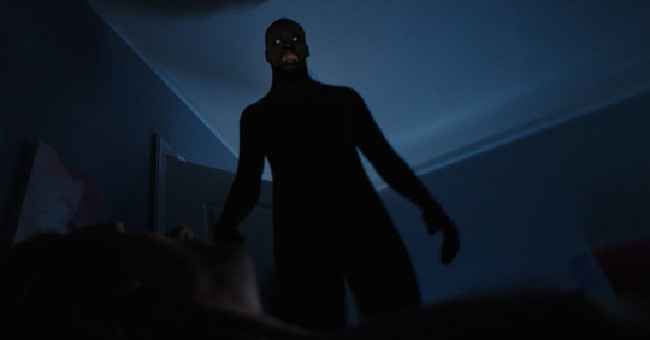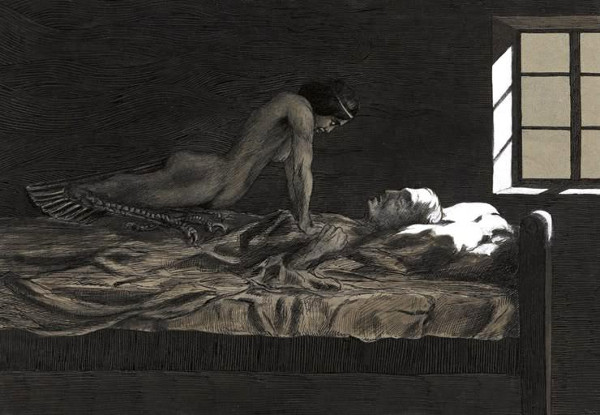The phenomenon of shadow under the scientific perspective
Certainly everyone once experienced in life feeling startled in the night, awake, feeling around but immobile. That phenomenon is called a shadow, an experience no one wants to encounter. So what is the cause of people getting shadowed and how to get rid of that scary situation?

Decode the shadow phenomenon
"I woke up in bed. There were two strangers in the corner of the room. I couldn't see them but knew they were there and what they looked like. I could hear them murmuring chatting, the story turned. I could not move, suddenly there was a man approaching, right above me, he spit out the spit at my closed eye socket, I could feel it clearly. That fluid is flowing on the face, " a project participant studied the phenomenon of depressive shadow depiction.
According to IBTimes, the description as in this film is actually a completely real experience of participants in research projects on sleep paralysis , also known as ballooning . It was an abnormal state that caused people to wake up at night but could not move their limbs, and often felt a lot of terrifying strange hallucinations.
Hallucinations and risks
Sleep paralysis usually occurs at the beginning of the night , at the beginning of sleep, or at the end of the night, when preparing to wake up. When a person has a balloon, hallucinations appear that can produce many scary experiences. Can classify hallucinations according to three groups.

The painting depicts the shadowing phenomenon in the 1915 book "My dream, my bad dream " by Fritz Schwimbeck.(Photo: Wikipedia).
Intrusion hallucinations are the feeling of the appearance of bad guys in the room, sometimes turning into surreal polygon illusions of a real intruder.
The illusion of illusion , often appearing simultaneously with intrusion hallucinations, is the feeling of being weighed down on the chest and suffocated to suffocate.
The third type is the hallucinations associated with vestibular disorders , which rarely appear with the two types of hallucinations, giving the impression of virtual motor experiences such as floating sensation, indeterminate free fall.
Shading is a common phenomenon that has been recorded for a long time, in almost every culture from ancient times. This phenomenon was recorded by Chinese in the history stories more than 3,000 years ago, even, the shadow is also present in the Renaissance painting of Swiss artist Henry Fuseli in 1781.
In the UK, in a study published in the August issue of Sleep by author Dan Dennis, University of Sheffield, 30% of the 862 respondents said they had undergone at least one stroke. in life. About 8% of them say they often suffer from this phenomenon when they sleep. Systematically synthesized from more than 30 research works around the world indicates that 10% of the population suffers from sleep depressions.
Shading is a common symptom of narcolepsy, a sleep disorder that is interrupted by the brain's ability to regulate normal sleep-sleep cycles. Stress is also a common symptom of some mental patients , especially psychiatric trauma after trauma and panic patients.
Factor
Many people also suffer from stress that has nothing to do with mental illness or neurological symptoms. Dan Dennis's research shows that the leading factor is at risk of causing stress because of psychological stress, depression, anxiety or deadlock in life.
Even the quality of sleep has a significant impact on the patient suffering from the phenomenon of ballooning. Research on groups of people with abnormal sleep or interruption during night shift work shows that the risk of having a stressful phenomenon is quite high.
When examining the role of genetics, by comparing the frequency of metaphors in the twins of the same egg with other egg twins, the scientists found the genetic link to The phenomenon of ballooning. Even the transformation of a particular gene related to the sleep-wake cycle of humans can cause a shadow, although this is not yet confirmed.
Even seemingly normal sleep also includes many different stages, shown in the following figure:

Stage of sleep.(Photo: Dan Dennis).
From the state, people go through three stages until they fall asleep, which is the deepest level of non-REM. When returning to stage 1 of sleep, humans advance to REM (rapid eye movement) of sleep.
During REM, brain chemicals began to work, brain activity was extremely exciting, and dreams reached a climax. However, the body's active muscles, from arms, legs, and fingers, any muscle that is controlled when awake (except the eyes and respiratory system), is paralyzed. This state helps keep people still while the brain strives to draw the most monstrous scenarios. That is why some people sometimes experience a feeling of immobility when they sleep , or when they wake up but the muscles are still frozen.
In the study of the Tokyo Metropolitan Institute of Neuroscience scientists in 2012, they experimentally systematically removed each component of sleep to REM.
Accordingly, if interrupting the level of REM cycles, human sleep can reach REM-sudden onset (sudden-onset REM, or SOREM ). It is a condition when people go straight from REM sleep to REM, ignoring some other stages of sleep (this is indicated by a broken line on the diagram).
Soon after reaching the SOREM state, the test participants experienced a similar phenomenon of ballooning - reinforcing opinions from previous studies that interrupted sleep increased the risk of sex. Ball pressure during sleep.
This study also showed that the phenomenon of close proximity to sleep has REM status. What seems to happen during a stroke is a part of the brain that wakes up, fully awake, aware of things around, while another part of the brain, such as the motor nervous system, remains REM sleep causes most of the body's movement to be paralyzed. In other words, the conscious mind is completely alert but the body is not.
The records of brain activity during the ballooning process indicate that the stage is the only unique state of cognition. The electroencephalogram of the over-stressed process is completely different in shape from the electroencephalogram of the wake state or even REM sleep.
Therefore, this phenomenon does not completely belong to one side sleep or wake, but in the interwoven region.
Treatment
Shading is an unrealistic sleep disorder , that is, does not hurt the body, but if it continues to fall into this condition, it can lead to health hazards such as neurasthenia, fatigue fatigue, mood turmoil.
Sleepers are more susceptible to shade because this position often causes snoring, which can lead to a feeling of suffocation. This may explain why many patients often see ghosts pressing their chests or strangling them so they can't breathe.
Unfortunately, there is no effective cure for sleep paralysis so far, except for a few cases that respond well to antidepressants. Therefore, the best way is to build a healthy lifestyle, eat in moderation, participate in recreational activities, sports, avoid stress and create a habit of going to bed on time to avoid sleep disturbances. , when sleeping, there must be a comfortable sleeping position to make the whole muscle relax, the head is not twisted, the clothes must be spacious and the bedroom is airy.
In addition, you can cultivate knowledge to increase your ability to adapt to life, reduce pressure on work. In a study published in October 2014 by Sharpless BA, Washington State University, about 79% of respondents said that these healthy ways were very effective. Alternatively, instead of stopping the balloon, it may be possible to break it by moving a body part like a finger or relaxing the whole body. This method is believed to be effective by 54% of respondents.
- Why do you often see ghosts when you have a shadow?
- All things about love from a scientific perspective
- The truth about the strange shadow on the Moon
- The shadow phenomenon overcomes stories by images
- Decode the shadow phenomenon
- Scientific perspective on apocalyptic hypotheses
- Milk looks from a scientific perspective
- Video: Mysterious black shadow on the Moon
- Video: The mysterious dark shadow is as big as a country on the Pacific Ocean
- This is how I feel when I'm under shadow and what science says about it
- 10 spooky phenomena under a scientific perspective
- The image of the spectacle of the mountain shadow splashes into the clouds
 'Fine laughs' - Scary and painful torture in ancient times
'Fine laughs' - Scary and painful torture in ancient times The sequence of numbers 142857 of the Egyptian pyramids is known as the strangest number in the world - Why?
The sequence of numbers 142857 of the Egyptian pyramids is known as the strangest number in the world - Why? History of the iron
History of the iron What is alum?
What is alum?